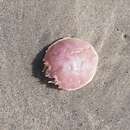en
names in breadcrumbs


"PSEUDOCORYSTES SICARIUS (Poeppig)
Plate 1, Figures 1-3
Corystes sicarius POEPPIG, Arch. f. Naturg., vol. 2, pt. 1, 1836, p. 139 (type-locality, deep water opposite Bay of S. Vincent, Chili; type in Leipzig Mus.).
Pseudocorystes armatus MILNE EDWARDS, Hist. Nat. Crust., vol. 2, 1837, p. 151 (type-locality, Valparaiso; cotype in Paris Mus.; cotype, Cat. No. 20276, U. S. Nat. MUS.).--MILNE EDWARDS and LUCAS, d'Orbigny 'S Voy. l'Arner. Merid., vol 6, pt. 1, 1844, p. 30; atlas, vol. 9, 1847, p1. 15, figs. 2-2c.
Pseudocorystes sicarius WHITE, Cat. Crust. Brit. Mus., 1847, p. 53.—RATHBUN, Proc. U. S. Nat. Mus., vol. 38, 1910, p. 576.—PORTER, Bol. Mus. Nac., Chile, 1913, p. 359, text-fig. 2 and synonymy; Revista Chilena Hist. vol. 22, 1918, p. 54, text-fig. 4 and synonymy.
Corystoides armatus PHILIPPI, Zool. Anz., vol. 17, 1894, p. 265.
Diagnosis.—Carapace nearly as broad as long, granulate; sides marginate, bidentate. Legs broad, natatory.
Description.—Carapace convex antero-posteriorly as well as from side to side; width about equal to length exclusive of rostrum. Two shallow crescentic furrows near center of carapace. Surface rough with crowded granules which are more acute and upstanding on the anterior half. Rostrum triangular, tridentate, median tooth the largest and most advanced. A sinus at middle of upper orbital border followed by two large teeth on the anterior margin of the carapace, the inner of which represents the external angle of the orbit. Two small teeth on the antero-lateral margin, the posterior one rudimentary; margin of teeth as well as of middle half of carapace thickly denticulate. Surface of chelipeds similar to that of carapace, granulation coarser and sharper toward upper margin. Merus armed with a small triangular spine near distal end of lower, outer margin; a strong spine-tipped tooth at inner angle of carpus, a spinule on inner surface, another smaller one on outer surface, sometimes absent; a denticle near middle of lower edge of propodus, and a series of spinules on upper margin of dactylus and adjacent margin of palm. Fixed finger triangular, broader at base than the dactylus. Fingers nearly meeting, each with about 6 or 7 low prehensile teeth. Remaining legs almost smooth, margins ciliated. Dactylus of last pair thinner than the others, which are flat on the anterior surface and convex on the posterior.
Color.—Carapace tawny-olive lighter in the center; chelipeds and legs wood brown. (After Milne Edwards and Lucas, fig.)
Measurements.—Male (54212), length of carapace 52.4, width of same 47.8, fronto-orbital width 19.5, width of front just anterior to supraorbital eave 6.6 mm.
Range.—West coast of South America, from Independencia Bay, Peru, to Straits of Magellan.
Material examined.—Independencia Bay, Peru; November 1919; Robert Cushman Murphy; 1 male (54212), received from Brooklyn Mus.
Valparaiso, Chile: Gay; 1 female, cotype of P. armatus Milne :Awards (20276), received from Paris Mus. 1 male (Copenhagen I us.).
Chile; 1 ovigerous female, lent by Sao Paulo Mus."
(Rathbun, 1930)